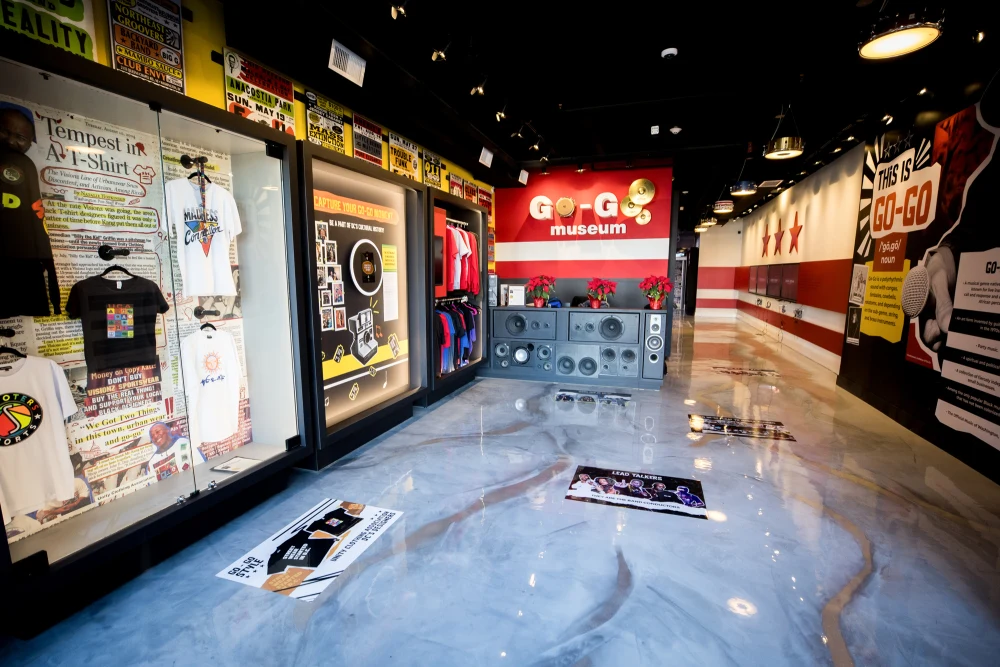In the nation’s capital, where a plethora of cultural institutions dot the landscape, a new arrival pulses with a go-go beat.
The Go-Go Museum & Café, the world’s only collection dedicated to the celebration, study and preservation of all things go-go, opens Wednesday in its birthplace, Washington, D.C.
For the uninitiated, the genre is a syncopated, drum-driven style of funk. Its distinctive sound is heavy on percussion instruments such as congas and cowbells, as well as brass horns. Go-go is often played live, where its exuberant rhythms soar. “It is a powerful expression of joy,” said Natalie Hopkinson, the museum’s chief curator, who wrote her Ph.D. dissertation about go-go. “It is an art form.”
While several bands played roles in early prototypes of the music, Chuck Brown, the “Godfather of Go-Go,” is widely credited with creating the genre in the 1970s. During a club performance with his band, The Soul Searchers, Brown reportedly had the percussion section play continuously between songs. Meanwhile, he engaged the audience in lively call and response. That groove — which goes and goes — became go-go.
A half-century later, go-go is still going. In 2020, it was designated the official music of Washington, D.C. Over the years, artists such as Brown, Rare Essence and Trouble Funk have appeared on NPR’s “Tiny Desk” concert series. Go-Go acts have also appeared at Pharrell Williams’s Something in the Water festival in Virginia, at the Kennedy Center and beyond.
“If you go to New Orleans, you’ve got brass bands. Go to New York, and it’s hip-hop. If you come to D.C., you’re hearing go-go,” said Ronald “Moe” Moten, the museum’s founder and president.
A promoter and peace activist, Moten grew up in a D.C. household that cranked go-go. “My mother would listen to it all the time,” Moten recalled. “It was just natural, part of the culture.”
Now, the museum that reflects the soundtrack of his life and that of countless other fans is opening to the public on Wednesday; a ribbon-cutting was held last year.
Nestled among businesses along Martin Luther King Jr. Avenue SE, the two-story structure houses a vibrant 8,000-square-foot space. The museum boasts more than a dozen interactive exhibits, a recording studio and a performance stage. Chef Angela Rose, a Food Network “Chopped” finalist, has created a diaspora street food menu for the on-site café.
Visitors can “talk” to an AI hologram of go-go stars or tap a screen to learn about go-go’s influence on hip-hop, complete with audio beats that have been sampled on rap songs.
Elsewhere are artifacts and installations that spotlight go-go in cinema, fashion and photography. Another exhibit centers the LGBTQ community. There’s a “street art” exhibit complete with a digital spray can for signature graffiti “tags.”
Not surprisingly, the museum gives props to go-go pioneers, royalty and popular entertainers. Besides Brown (who died in 2012), they include Experience Unlimited, aka E.U. (who became nationally known after appearing in Spike Lee’s 1988 film “School Daze”) and the all-woman band Be’ La Dona, to name a few.
Moreover, a museum timeline charts go-go’s history. Despite its proud evolution, Moten says there have been “ups and downs.” In the 1990s, reports of conflicts and violence in or around dance halls led to youth curfews.
In 2019, noise complaints from a luxury apartment building about a D.C. retailer playing go-go prompted backlash and protests. A #DontMuteDC hashtag started by a Howard University student went viral. Moten and Hopkinson then led the “Don’t Mute D.C. go-go music and culture” petition, which received about 80,000 signatures. The movement drew musicians, advocates and supporters nationwide and globally, and led to a push for DC Law 23-71. It repealed the curfews and made the music “official.”
Mayor Muriel Bowser, who signed the measure, has championed go-go, and her administration provided the museum with fiscal support.
“Go-go is the heartbeat of D.C.,” Bowser told NBC News through a spokesperson. She termed the museum “a living, breathing testament to the energy, creativity, and resilience of our community.”
Bowser added that the site “strengthens our creative economy by attracting visitors, supporting local artists, and fostering community engagement.”
The museum is already planning to welcome schools and host community programming and events. Recently, the museum officially launched its countdown to a historic initiative called “50 Years of Go-Go,” designed to mark the genre’s 50th anniversary in January 2026. The yearlong celebration will include a series of special events, pop-up exhibits and collaborations with museum partners.
Moten hopes their mission will help foster the next generation of musicians and enthusiasts, and spark a go-go renaissance across the country and around the world. The greater legacy, he said, is bringing people of myriad backgrounds together. It’s all about “just embracing the music and showing love.”

